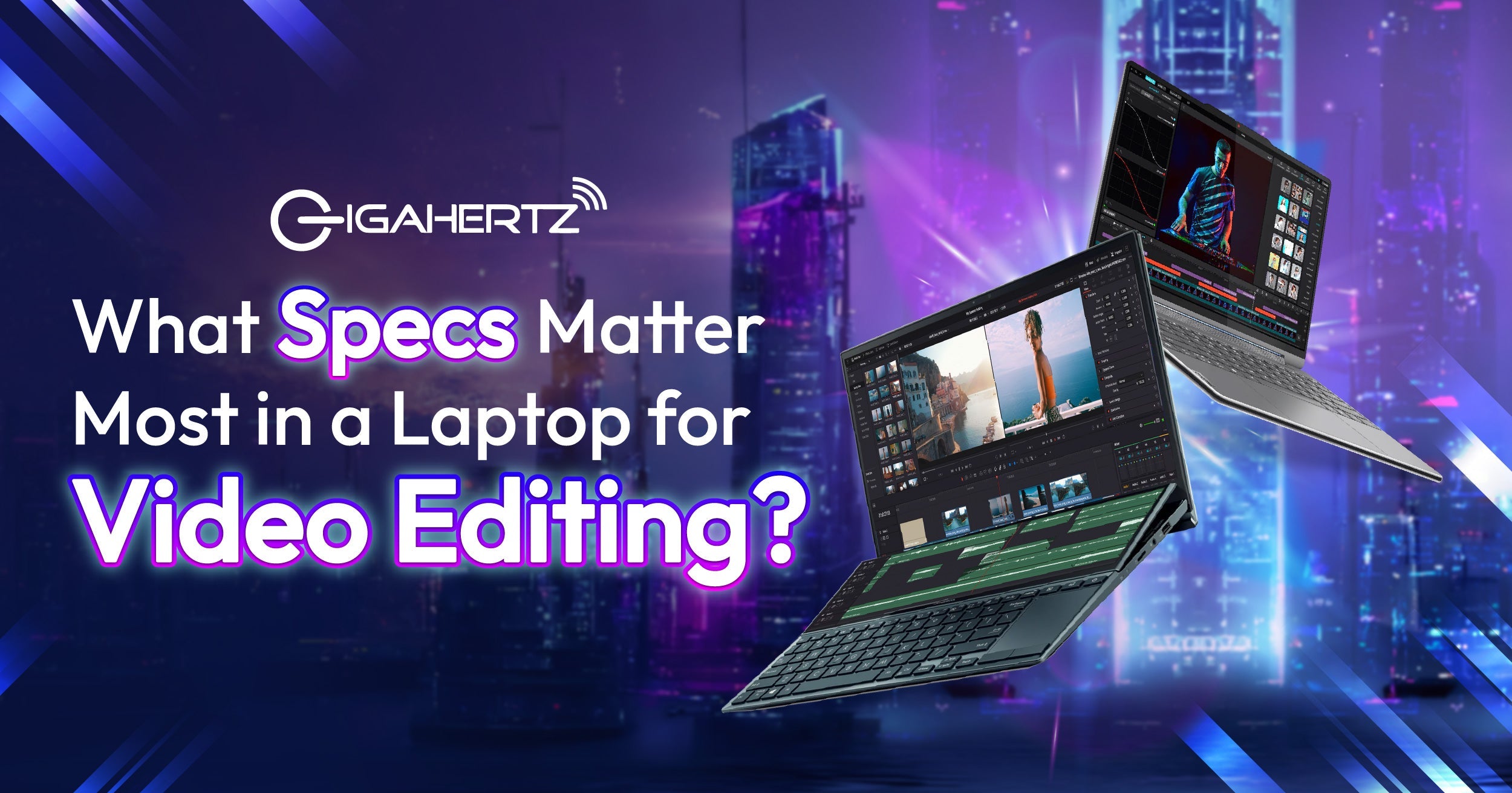Video editing professionals are what make any video a cinematic masterpiece. They’re a cornerstone of different fields of media and communications. Without them, we wouldn’t enjoy every reel we intake on the internet.
That’s why video editors need to have proper gear for their work so they can do their job better and serve us with enticing entertainment.
With all the new and updated editing tools, tech should also catch up. Because the wrong specs will lead to malfunctions, lag, and crashes, limiting creativity for the editors.
So if you’re an editor, a powerful laptop will be much better for you, especially since Same Day Edits (SDE) are becoming a standard in events. Here are the specifications that you should remember so you can have a much better-performing tool for editing.
1. The Engine Behind Every Cut: The Processor (CPU)
What to Look For:
- Intel Core i7 or i9 (11th gen or newer)
- AMD Ryzen 7 or Ryzen 9 (H-series preferred)
When editing videos, your laptop’s processor (CPU) is doing a lot of the heavy lifting—from rendering previews to exporting final cuts.
Multi-core CPUs (at least 6 cores) handle editing tasks more efficiently, especially when dealing with high-resolution footage, effects, or multitasking with apps like Adobe Premiere Pro, DaVinci Resolve, or After Effects.
2. Powering Playback and Effects: The Graphics Card (GPU)
Recommended GPUs:
- NVIDIA GeForce RTX 3050, 3060, 4060, or higher
- AMD Radeon RX 6000 series or better
While the CPU handles general tasks, the GPU (graphics card) plays a key role in rendering effects, transitions, and real-time playback, especially in GPU-accelerated software. A good GPU can drastically reduce rendering times and allow smoother scrubbing through footage, especially in 4K or 6K projects.
3. Avoid Freezing while Editing: The RAM
Minimum RAM to look for:
- 16GB for 1080p editing
- 32GB (or more) for 4K+ or RAW workflows
Editing video eats up RAM quickly, particularly when you're working with high-resolution media or running multiple apps. More RAM = smoother multitasking and better playback performance. It’s what allows your machine to keep up with timelines, color grading, and background rendering without slowing down.
4. Speed + Space: Storage
Must-haves:
- SSD (Solid State Drive)—ideally NVMe for ultra-fast read/write speeds
- 512GB minimum; 1TB+ if working with large project files
- External SSDs for media storage and project backups
Storage isn’t just about capacity—it’s about speed. A slow drive can turn editing into a frustrating experience. A tip we can give is to keep your OS and editing software on the internal SSD, and store raw footage externally to keep performance high.
5. Color Accuracy Counts: Display
Display Specs to Look For:
- 1080p minimum resolution (4K ideal for fine editing)
- IPS panel for better viewing angles and color accuracy
- 100% sRGB or DCI-P3 color coverage
If you plan to color correct or grade your footage, your laptop’s display needs to be accurate, not just pretty. Screen size matters too. A 15-inch or larger display gives you more timeline space and better visibility while editing.
6. Battery Life: Secondary but Still Important

Most editing happens while plugged in, but decent battery life still matters for fieldwork or travel.
The ASUS ZenBook series offers good performance/battery balance.
Lenovo Yoga and ThinkPad models are great for light editing on the move.
Acer Swift balances creative power with portability and a decent battery.
7. Ports & Connectivity: No Dongle Required
Must-Have Ports:
- USB-C / Thunderbolt 4
- Full-size SD card reader
- HDMI
- USB-A
Editors use SD cards, external drives, and second monitors constantly. Your laptop should support this natively.
All three brands offer robust connectivity:
- Lenovo Legion and ThinkPad X1 models have full-size ports and Thunderbolt.
- ASUS ZenBook 14 includes HDMI and an SD reader.
The Acer Predator line is made with creators in mind, with multiple I/O options.
8. Software Compatibility: Windows’ Performance

ASUS, Lenovo, and Acer offer serious competition, often at a better value. And with OLED screens, RTX GPUs, and high-refresh-rate displays, they often outperform competitor laptops in key video editing benchmarks, especially in DaVinci Resolve and Adobe Premiere Pro.
Best Video Editing Laptops (GigaHertz Approved)
|
Brand |
Model |
Key Specs |
Ideal For |
|
ASUS |
ROG Zephyrus G16 |
Intel Ultra 9, RTX 5070, 1TB SSD |
4K editing, heavy FX |
|
ASUS |
ROG Strix G18 |
Intel i9, RTX 4070, 1TB SSD |
Color grading, pro work |
|
Lenovo |
Legion Pro 5 |
Intel i7, RTX 4060, 512TB SSD |
Gaming + editing combo |
|
Lenovo |
Yoga Pro 7 |
Ryzen 7, RTX 3050, 1TB SSD |
Portable creative editing |
|
Acer |
Predator Helios 18 |
Intel Ultra 9, RTX 5080, 2TB SSD |
Color-accurate workflows |
Final Thoughts!
A great video editing laptop balances CPU power, GPU performance, sufficient RAM, fast storage, and a color-accurate display. Whether you’re an amateur YouTuber or a professional filmmaker, investing in the right machine will not only save you time—it’ll save your sanity. Always think ahead.







